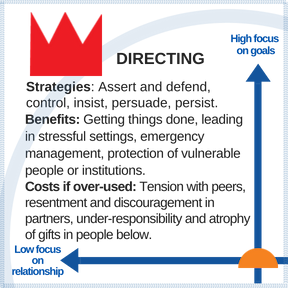 We’re reading a lot these days about leaders who bully.
We’re reading a lot these days about leaders who bully.
In “When the Boss is a Bully”, a recent NY Times article points out that aggressive toughness has its rewards. Some people like the idea of a very task focused leader. Better to have a leader who gets the job done, albeit rudely, than one who nicely fails to deliver.
People tend to extend the benefit of any doubt to a leader who acts decisively, according to research cited in the Times article. One researcher calls this the “leader’s rosy halo” effect, a tendency for others to fall back and follow someone who is bold, decisive, and confident. There is no evidence pushy leaders offer better solutions than anyone else, but others are attracted to decisiveness and tend to follow.
Conflict Styles and Strong Leadership
A key concept in the conflict styles framework is that every conflict style has strengths and weaknesses. We need all five styles. Don’t write off toughness just because it’s not nice.
framework is that every conflict style has strengths and weaknesses. We need all five styles. Don’t write off toughness just because it’s not nice.
I learned this the hard way in my twenties when I found myself regretting I had not been more firm with my dog in training. One day she ignored my call, as she often did. She ran onto a road, and died under a car.
Parents learn that there are moments when failure to be strict is to put a child’s life or well-being at risk. And in a health emergency, we want a doctor who takes charge and give orders to co-workers, not one who dallies in nice dialogue with colleagues.
Every one has moments when insisting on something, without worrying about relationships or feelings of others, is the only right response. We should all cultivate the ability to be tough on demand for such moments. We should value leaders who can do that when duty requires it.
But toughness is an asset only in occasional doses. As a habit, a primary way of interacting, it’s a liability whose damage grows with time.
In organizations, the costs of over-use by leaders can be vast. Competent, loyal individuals leave, teamwork deteriorates, aggressiveness spreads like a virus into all levels of the institution, morale plummets.
Costs often take a while to become evident. By the time they are acknowledged, the damage is huge and recovery slow.
How to Maintain a Wise Balance
Are you a leader who’s pushy at times? I hope so. You may not be doing your job if your answer is never. But do you hold a healthy balance between pushing and nurturing?
Here are suggestions, drawn from the score report of my Style Matters conflict style inventory, for using the goal-oriented Directing conflict style (in the Thomas Kilmann instrument, Forcing) wisely, without falling into overuse:
- Increase your context awareness. Directing is a gift where strong coordination and direction from one person are essential. It’s a requirement occasionally, not all the time. Where partnership, equality and consultation are expected, others resent over-use of Directing. Recognize this and you will avoid the Achilles Heel of this style. Read the settings you are in and adapt accordingly. When in doubt, dial back on Directing instincts. You can ratchet up assertiveness later if required, whereas relationships may never recover from the resentment you will cause if you misjudge circumstances and impose yourself inappropriately.
- Expand your skills in other conflict styles so you need not rely more than necessary on Directing. In particular, master the skills of the Cooperating style which, like directing, is assertive, but adds relational skills. For example….
- Hone skills in listening well. Being a good listener rarely detracts from the ability to act decisively when necessary and the info gained increases your ability to make good decisions. Plus, if you are a good listener, others are more likely to experience you as having strength tempered by wisdom rather than as simply pig-headed.
- Work on relationships. Look for opportunities to support, affirm, appreciate others. Read Support Strategies for specifics on how to support each of the other styles. The Support Strategies for Cooperating, Harmonizing, and Avoiding will be especially useful info for you, for they guide in doing things that many high-energy Directors never realize others need.
- Be in charge in ways that respect and honor others. Being both strong and supportive towards others is an art that requires practice. Pay close attention to your tone of voice and body language, for much is communicated by these. If in doubt, request feedback from people you trust who are not subject to you.
- Consult where possible. Invite input from others and incorporate as much as you can into your work. Doing this does not remove your authority to make final decisions. The skills described above take time and effort to develop, but you can start consulting immediately. Remember, consulting is not negotiating. View it as a time to listen, learn, and gather input (about both the issues and about how people are experiencing the discussion process), not as a time to persuade.
Take my Style Matters conflict style inventory and get practical suggestions tailored to your own unique blend of conflicts here. 80% of users say they’d recommend it to others. We’ll cheerfully refund the $8 cost if you’re not fully satisfied.

